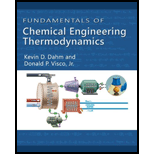
You are interested in finding the pressure at which the first bubble of vapor will form from a liquid mixture of ethanol (1) and benzene (2) (49% by mole ethanol) at 313 K. The Margules parameters for this mixture are A12 = 2.173 and A21 = 1.539, while the Wilson parameters for this mixture are a12/R = 653.13 K and a21/R = 66.16 K. Find the pressure and vapor-phase composition using three ways.
A. The 2-parameter Margules equation
B. The Wilson equation
C. Ideal solution
(A)
Interpretation:
The pressure and vapour-phase composition using 2-parameter Margules equation.
Concept Introduction:
Write the expression to obtain the liquid mole fraction of benzene
Here, liquid mole fraction of ethanol is
Write the expression to obtain the activity coefficient of component 1
Here, Margules parameters are
Write the expression to obtain the activity coefficient of component 2
Write the expression of vapor pressure using Antoine equation.
Here, temperature in degree Celsius is
Write the expression to obtain the pressure
Write the expression to obtain the vapor phase composition.
Here, mole fraction of component 1 is
Write the expression to obtain the mole fraction of component 2
Explanation of Solution
Given information:
Margules parameters are
Write the expression to obtain the liquid mole fraction of benzene
Substitute 49% mole for
Write the expression to obtain the activity coefficient of component 1
Substitute
Write the expression to obtain the activity coefficient of component 2
Substitute
Write the expression of vapor pressure using Antoine equation.
From Appendix E, “Antoine Equations”, write the following properties for component 1 and 2 as in Table (1).
| Parameters | Ethanol | Benzene |
| A | 8.321 | 6.905 |
| B | 1718.10 | 1211.03 |
| C | 237.52 | 220.79 |
Convert the unit of temperature.
Substitute
Substitute
Write the expression to obtain the pressure
Substitute
Thus, the pressure at which the first bubble of vapor will form is
Write the expression to obtain the vapor phase composition.
Substitute
Thus, the mole fraction of component 1 is
Write the expression to obtain the mole fraction of component 2
Substitute
Thus, the mole fraction of component 2 is
(B)
Interpretation:
The pressure and vapour-phase composition using the Wilson equation.
Concept Introduction:
Write the expression to obtain the temperature dependent parameters of the Wilson equation
Here, Wilson parameter is
Write the expression to obtain the temperature dependent parameters of the Wilson equation
Here, Wilson parameter is
Write the expression to obtain the activity coefficient of component 1
Write the expression to obtain the activity coefficient of component 2
Write the expression to obtain the pressure
Write the expression to obtain the vapor phase composition.
Here, mole fraction of component 1 is
Write the expression to obtain the mole fraction of component 2
Explanation of Solution
Given information:
Wilson parameters are
Refer appendix C.1, “Critical point, enthalpy of phase change, and liquid molar volume”, obtain the liquid molar volume
| Compound |
liquid molar volume |
| Ethanol (1) | 58.68 |
| Benzene (2) | 89.41 |
Write the expression to obtain the temperature dependent parameters of the Wilson equation
Substitute
Write the expression to obtain the temperature dependent parameters of the Wilson equation
Substitute
Write the expression to obtain the activity coefficient of component 1
Substitute
Write the expression to obtain the activity coefficient of component 2
Substitute
Write the expression to obtain the pressure
Substitute
Thus, the pressure at which the first bubble of vapor will form is
Write the expression to obtain the vapor phase composition.
Substitute
Thus, the mole fraction of component 1 is
Write the expression to obtain the mole fraction of component 2
Substitute 0.392 for
Thus, the mole fraction of component 2 is
(C)
Interpretation:
The Ideal solution.
Concept Introduction:
Write the expression to obtain the pressure
Write the expression to obtain the vapor phase composition.
Here, mole fraction of component 1 is
Write the expression to obtain the mole fraction of component 2
Explanation of Solution
Write the expression to obtain the pressure
Substitute
Thus, the pressure at which the first bubble of vapor will form is
Write the expression to obtain the vapor phase composition.
Substitute
Thus, the mole fraction of component 1 is
Write the expression to obtain the mole fraction of component 2
Substitute 0.415 for
Thus, the mole fraction of component 2 is
Want to see more full solutions like this?
Chapter 11 Solutions
Fundamentals of Chemical Engineering Thermodynamics (MindTap Course List)
 Introduction to Chemical Engineering Thermodynami...Chemical EngineeringISBN:9781259696527Author:J.M. Smith Termodinamica en ingenieria quimica, Hendrick C Van Ness, Michael Abbott, Mark SwihartPublisher:McGraw-Hill Education
Introduction to Chemical Engineering Thermodynami...Chemical EngineeringISBN:9781259696527Author:J.M. Smith Termodinamica en ingenieria quimica, Hendrick C Van Ness, Michael Abbott, Mark SwihartPublisher:McGraw-Hill Education Elementary Principles of Chemical Processes, Bind...Chemical EngineeringISBN:9781118431221Author:Richard M. Felder, Ronald W. Rousseau, Lisa G. BullardPublisher:WILEY
Elementary Principles of Chemical Processes, Bind...Chemical EngineeringISBN:9781118431221Author:Richard M. Felder, Ronald W. Rousseau, Lisa G. BullardPublisher:WILEY Elements of Chemical Reaction Engineering (5th Ed...Chemical EngineeringISBN:9780133887518Author:H. Scott FoglerPublisher:Prentice Hall
Elements of Chemical Reaction Engineering (5th Ed...Chemical EngineeringISBN:9780133887518Author:H. Scott FoglerPublisher:Prentice Hall
 Industrial Plastics: Theory and ApplicationsChemical EngineeringISBN:9781285061238Author:Lokensgard, ErikPublisher:Delmar Cengage Learning
Industrial Plastics: Theory and ApplicationsChemical EngineeringISBN:9781285061238Author:Lokensgard, ErikPublisher:Delmar Cengage Learning Unit Operations of Chemical EngineeringChemical EngineeringISBN:9780072848236Author:Warren McCabe, Julian C. Smith, Peter HarriottPublisher:McGraw-Hill Companies, The
Unit Operations of Chemical EngineeringChemical EngineeringISBN:9780072848236Author:Warren McCabe, Julian C. Smith, Peter HarriottPublisher:McGraw-Hill Companies, The





